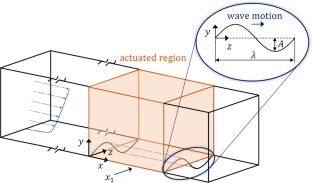Impact of Reynolds Number on the Drag Reduction Mechanism of Spanwise Travelling Surface Waves
Abstract
The mechanism that provokes friction drag reduction in a turbulent boundary layer flow which is actively controlled by spanwise travelling transversal surface waves is investigated. The focus is on discussing the drag reducing mechanism for a low and a moderately high Reynolds number. At the low friction velocity based Reynolds number \(Re_\tau \approx 393\), the periodic secondary flow field induced by the surface actuation interacts with the quasi-streamwise vortices. An elliptic deformation of these vortices initiates their breakup and the reduced amount lowers the overall wall-shear stress level due to the consequently attenuated high-speed streaks. At the moderately high Reynolds number \(Re_\tau \approx 1525\), the effectiveness of this mechanism is reduced but a second contributor occurs, which manipulates the inner–outer interaction. The large-scale motions of the log layer can less effectively impose their footprint onto the near-wall flow field since large-scale ejections, which are introduced by the surface actuation in the near-wall region, balance the outer-layer sweeps. Since the outer-layer impact on the inner region is intensified by increasing Reynolds number, its disruption is beneficial as to a successful application of this drag reduction method to engineering relevant Reynolds numbers.


 求助内容:
求助内容: 应助结果提醒方式:
应助结果提醒方式:


